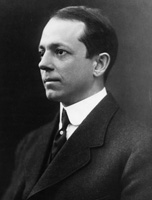Henry S. Graves (1871-1951)
2nd Chief of the Forest Service, 1910-1920

Henry S. Graves
Henry "Harry" Solon Graves was born in Marietta, Ohio, on May 3, 1871. He graduated from Yale in 1892, then received his masters degree in 1900. Graves, once second in command under Pinchot in the Division of Forestry, was the dean of forestry at Yale. He was a close friend of Pinchot's and one of the original seven members of the Society of American Foresters, which was formed at Pinchot's home in November of 1900. Graves was an eminent professional forester, serving as the first professor and director of the newly founded Yale Forest School.
He was selected to take over the reigns of the five-year-old Forest Service in 1910, after the firing of Gifford Pinchot by President Taft. Graves was described as strongly puritanical and no-nonsense (he frowned on smoking in the office and forbade whistling), yet he commanded respect and even affection from his staff. Graves felt the burden of trying to rebuild the morale that was shattered by Pinchot's firing. Initially, Graves had to restore relations with the Department of the Interior, then work to bring about a strong Forest Service. He also had to fight to keep control of the national forests, as there were a number of state and private interests that wanted the forests returned to state or local control. He and his staff successfully went to work to show that the Forest Service was the best qualified agency to manage the national forests.
"When the policy of deeding away the public timberlands was at last found an unsafe one for the Nation, it was changed and the bulk of the remaining public timberlands were withdrawn from public appropriation and segregated as national forests. In this way about 155 million acres, nearly all in the western mountains, were reserved....The public forests are being protected from fire, the timber is used as it is called for by economic conditions, and the cutting is conducted by such methods as leave the land in favorable condition for the next crop of timber.
The very magnitude of the national forest enterprise has created in the minds of many people the impression that the problem in this country is already on the way to definite solution. In point of fact, only certain initial steps have been taken....It is my hope that we may secure sufficient public support to enable us to accelerate the acquisition by the Government of the important remaining areas before it is too late....Forests on critical watersheds should be owned by the public for their protective value. Public forests serve, also, as centers of co-operation with private owners and as demonstration areas for the practice of forestry as well as furnishing their direct benefits in producing wood materials, as recreation grounds, etc."
Henry Graves
Soon after the declaration of war in the spring of 1917, Graves was commissioned as a major in the Corps of Engineers and sent to France to make advance preparations for the 10th Engineers (Forestry), and later the 20th Engineers. He returned to America in the spring of 1918 as a lieutenant colonel and soon after inaugurated a movement looking towards developing a national forest policy for the U.S.

Henry S. Graves (right) with F. Franklin Moon at New York State College of Forestry facilities at Cranberry Lake, circa 1920.
His ten-year stint as chief of the Forest Service was characterized by a stabilization of the national forests, purchase of new national forests in the East, and a strengthening of the foundations of forestry by putting it on a more scientific basis. But his great contribution was the successful launching of a national forest policy for the United States, a permanent and far-reaching achievement. During his tenure as chief, the Forest Products Laboratory was established at Madison, WI; the Weeks Law was enacted in 1911 allowing federal purchase of forest lands (mostly in the East); and the research branch of the Forest Service was organized.
Additional Resources
- A Policy of Forestry for the Nation, 1919 [PDF].
- Purchase of Land under the Weeks Law in the Southern Appalachian and White Mountains, 1911 [PDF].
- Graves Describes Work of Forest Regiments, 1918 [PDF].
- Henry S. Graves U.S. Forest Service Headquarters Collection Biographical File [PDF].

